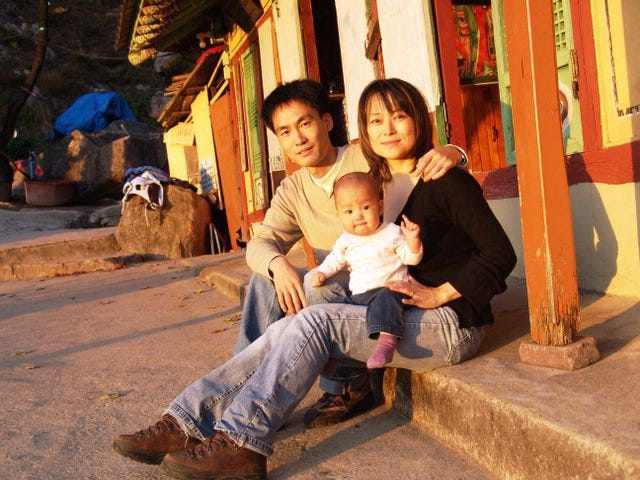Behind the Scenes: The Long Road to 'A Brief History of Korean Martial Arts
After years in the making, we finally crossed the finishing line of this labor of love. Bringing this book to life is a moment I've been waiting for almost half of my life.
You may have noticed our recent pause in content creation. We've been working around the clock to perfect the anticipated book for its launch on April 10th. In this post, I'd like to share why this book means so much to me personally.
The Start of My Quest
Born in Korea but raised in the Netherlands by Dutch parents, I discovered martial arts as a form of empowerment from an early age. At just four years old, I was already using joint locks against playground bullies—techniques I'd watched my older brother practice back in Korea. My Dutch mother often reminisced about watching me rage against the tallest boys in the schoolyard, taking them on with my self-invented kicks and punches whenever they hurled racist slurs my way. In the area of white privilege I grew up in, racism was not considered as something unacceptable, but my makeshift martial arts gave me protection. Mom would proudly recount these stories for years.
Years later, when I trained in taekwondo, I felt that same confidence walking through questionable areas during my travels. While I never needed to use these skills (thankfully), they gave me a sense of preparedness and connection to my Korean roots.
That connection hit a roadblock though when I learned taekwondo wasn't the ancient Korean art I'd imagined, but rather re-engineered Japanese karate from the colonial era. This discovery sparked a quest to find authentic traditional Korean martial arts—a quest that led me to the guy who’s now my husband. He had just completed his dissertation on this very subject and was invited to showcase his martial arts in Spain, his first trip to Europe.
From Busan to Book
In fall 2005, we found ourselves in Busan with our six-month-old daughter. My husband was a fulltime professor at Yongsan University while I navigated new motherhood in a refurbished Buddhist temple we had transformed into "Hanguk Muyewon" (Korean Martial Arts Center). Surrounded by a collection of 4,000+ books on Oriental martial arts, I connected with Western practitioners online through early forums like Bullshido and Hapkidoforum. On a side note: this was pre-Facebook or WhatsApp. Online social life meant being a keyboard warrior on special interest forums back then.
The disconnect was obvious—Western practitioners of Korean martial arts lacked the contextual knowledge available in Korean universities. I urged my husband to write a comprehensive history from a scholarly perspective, based on verifiable facts rather than the myths and misconceptions prevalent in the West.
Life, however, had other plans. We moved to the Netherlands in 2007 to provide a different educational environment for our children. Financial constraints, research funds cuts following the 2008 crisis, raising three children, and caring for my aging parents pushed our book project to the back burner. I pursued a business career in the corporate world to provide for the family while my husband preserved the Korean martial heritage in both theory and practice. The time passed by like a blink—one moment we were discussing this book with a baby on my lap, and suddenly twenty years had flown by, our children nearly grown and our lives transformed in countless ways.
The Time Has Come
Now, with our children grown (our first baby turns 20 next month!), my parents having passed, and a moment to breathe, we've finally delivered on that long-held promise. Over the past few weeks, we've worked like freaks to distill 600+ pages of my husband's research into 320 pages of accessible text and illustrations.
The layout, romanization challenges, and editing for Western readers has been intensive but fulfilling work. It brings back memories of those spirited online debates with martial arts enthusiasts twenty years ago—Klaas Barends, Bruce Sims, JB Jaeger, Jeremy Talbot, David Ortiz, Austin Seo, Damian Adams, Swallow, some Argentine guy named Juan and many others whose passionate discussions helped shape our thinking.
While my husband dedicates this book to his parents, I dedicate it to those early online sparring partners who showed me how hungry the Western world was for accurate information about Korean martial arts.
"A Brief History of Korean Martial Arts" isn't just an academic text—it's the first historical overview written specifically for general readers, tracing the evolution of these arts from prehistory to present day. It represents both scholarly rigor and personal passion, bridged by our shared commitment to appreciating Korea's martial heritage and honoring our ancestors.
I hope you'll join us on April 10th (at Leiden University or online) for this long-awaited release. Twenty years in the making, but worth every minute.
🎯 Are you a dojang owner and are you interested to enlighten your students with this material? Become our affiliate partner! Send me a note and join us.
🎯 We'd love to hear your thoughts once you've read it—share your candid review on our book page and we'll thank you with a complimentary 6-month subscription.






Soo,
Thank you for this beautiful post — and of course, for your husband’s work. As soon as it’s available on Amazon, I’ll be sure to buy it.
Life has helped us grow in many ways.
The masters who brought martial arts to the West also brought with them a version of history that often didn’t match reality.
In my personal experience, for example, I believe the best way to honor Master Yoo Soo Nam is by recognizing him for what he truly was: the founder of his martial art, rather than an inheritor of an ancient tradition.